Business Law: Analysis of Housing Affordability Crisis in NSW
VerifiedAdded on 2021/06/17
|14
|2707
|308
Report
AI Summary
This report examines the housing affordability crisis in New South Wales (NSW), Australia, focusing on the relationship between house prices and income levels. It highlights the decline in housing affordability since 1980, supported by data such as the house price to income ratio, which has significantly increased over the years. The report analyzes the impact of this crisis, citing the expensive housing market of Sydney as a major factor, which has forced essential workers to move out of the city. It explores the house price to income ratio as a key indicator, comparing Sydney's affordability to other major cities globally. The report also examines the reasons behind high housing prices, including low interest rates and supply-demand imbalances. It concludes by emphasizing the challenges faced by low-income Australians in purchasing homes and suggests recommendations such as macro prudential measures and policies to boost new housing supplies to address the crisis.
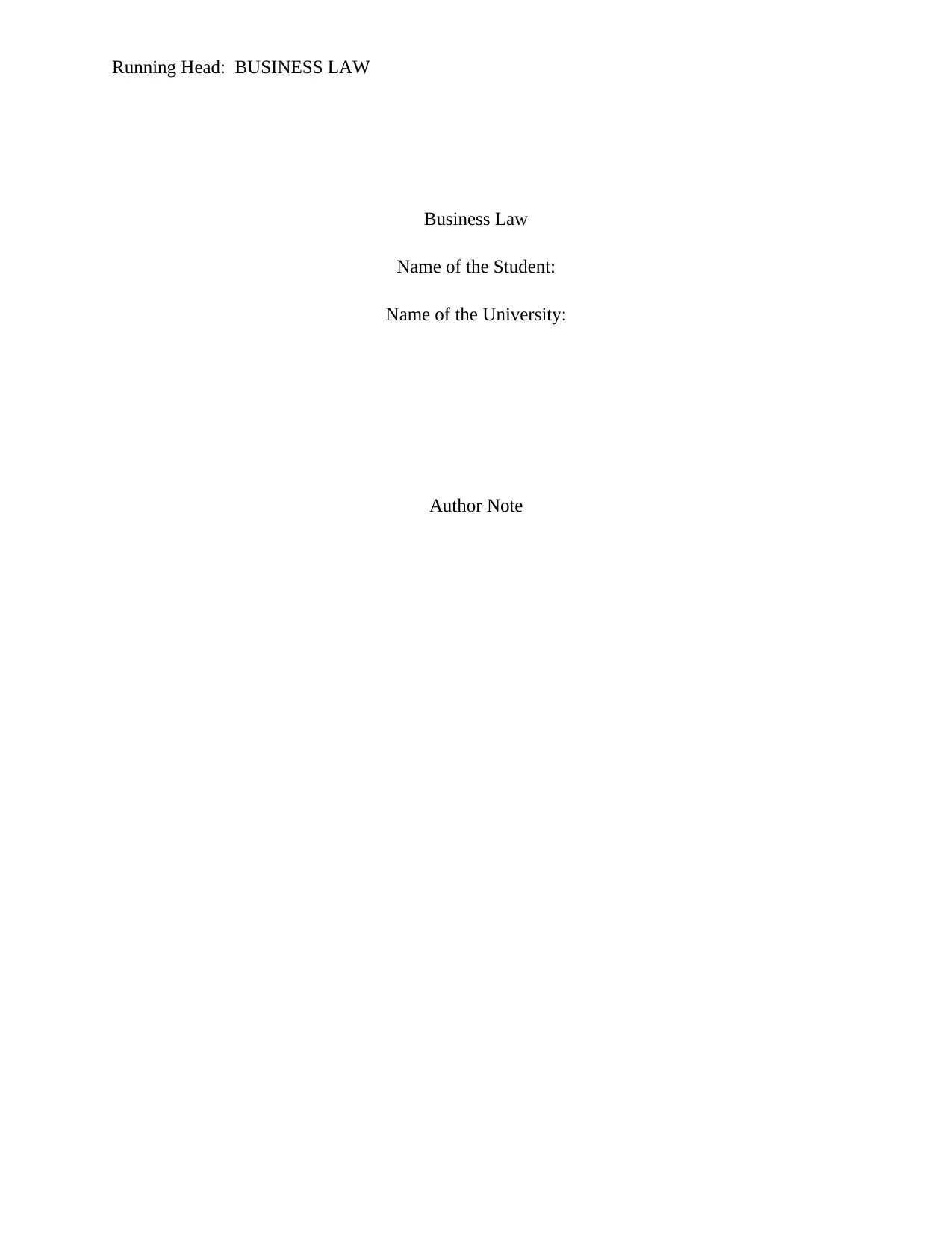
Running Head: BUSINESS LAW
Business Law
Name of the Student:
Name of the University:
Author Note
Business Law
Name of the Student:
Name of the University:
Author Note
Paraphrase This Document
Need a fresh take? Get an instant paraphrase of this document with our AI Paraphraser
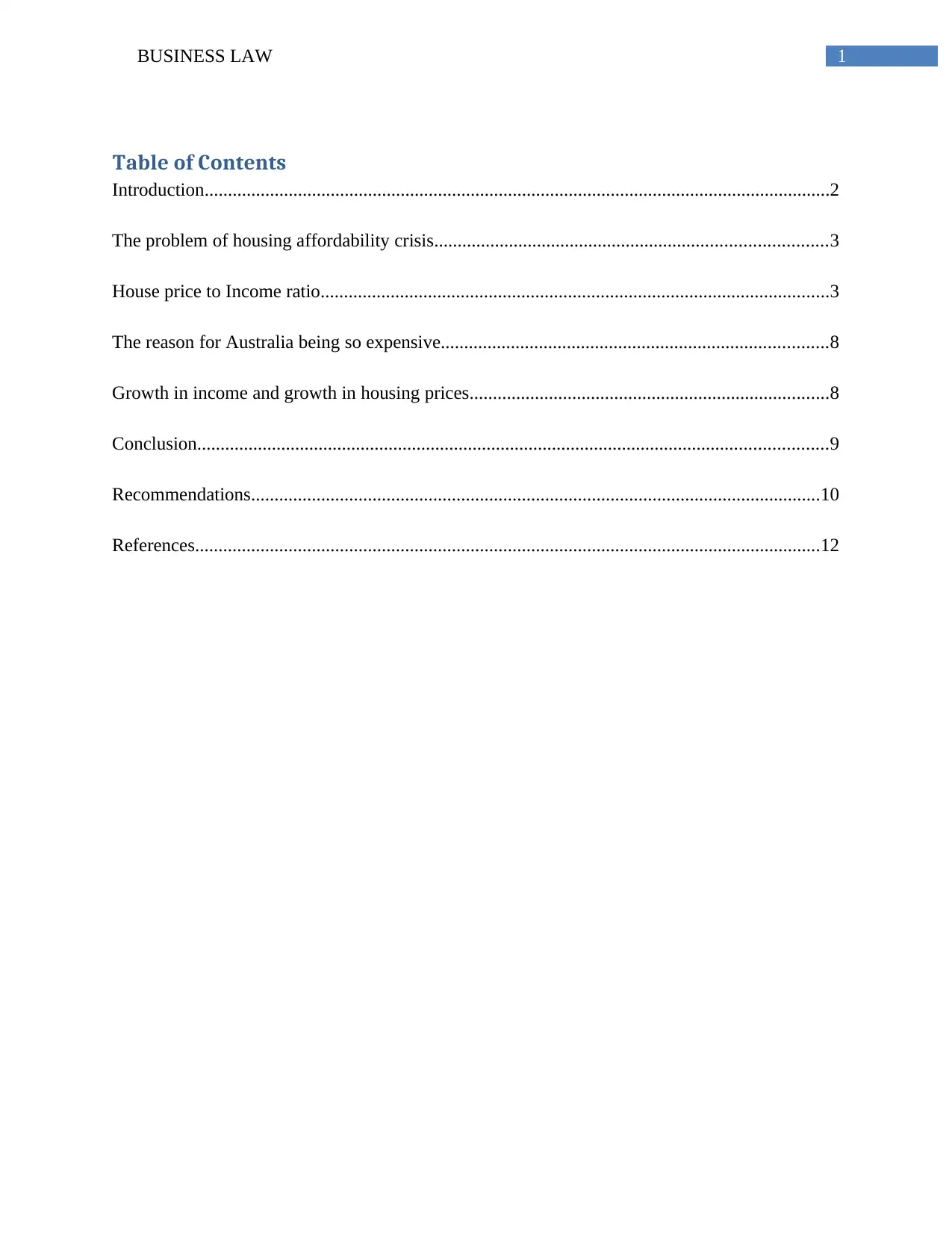
1BUSINESS LAW
Table of Contents
Introduction......................................................................................................................................2
The problem of housing affordability crisis....................................................................................3
House price to Income ratio.............................................................................................................3
The reason for Australia being so expensive...................................................................................8
Growth in income and growth in housing prices.............................................................................8
Conclusion.......................................................................................................................................9
Recommendations..........................................................................................................................10
References......................................................................................................................................12
Table of Contents
Introduction......................................................................................................................................2
The problem of housing affordability crisis....................................................................................3
House price to Income ratio.............................................................................................................3
The reason for Australia being so expensive...................................................................................8
Growth in income and growth in housing prices.............................................................................8
Conclusion.......................................................................................................................................9
Recommendations..........................................................................................................................10
References......................................................................................................................................12
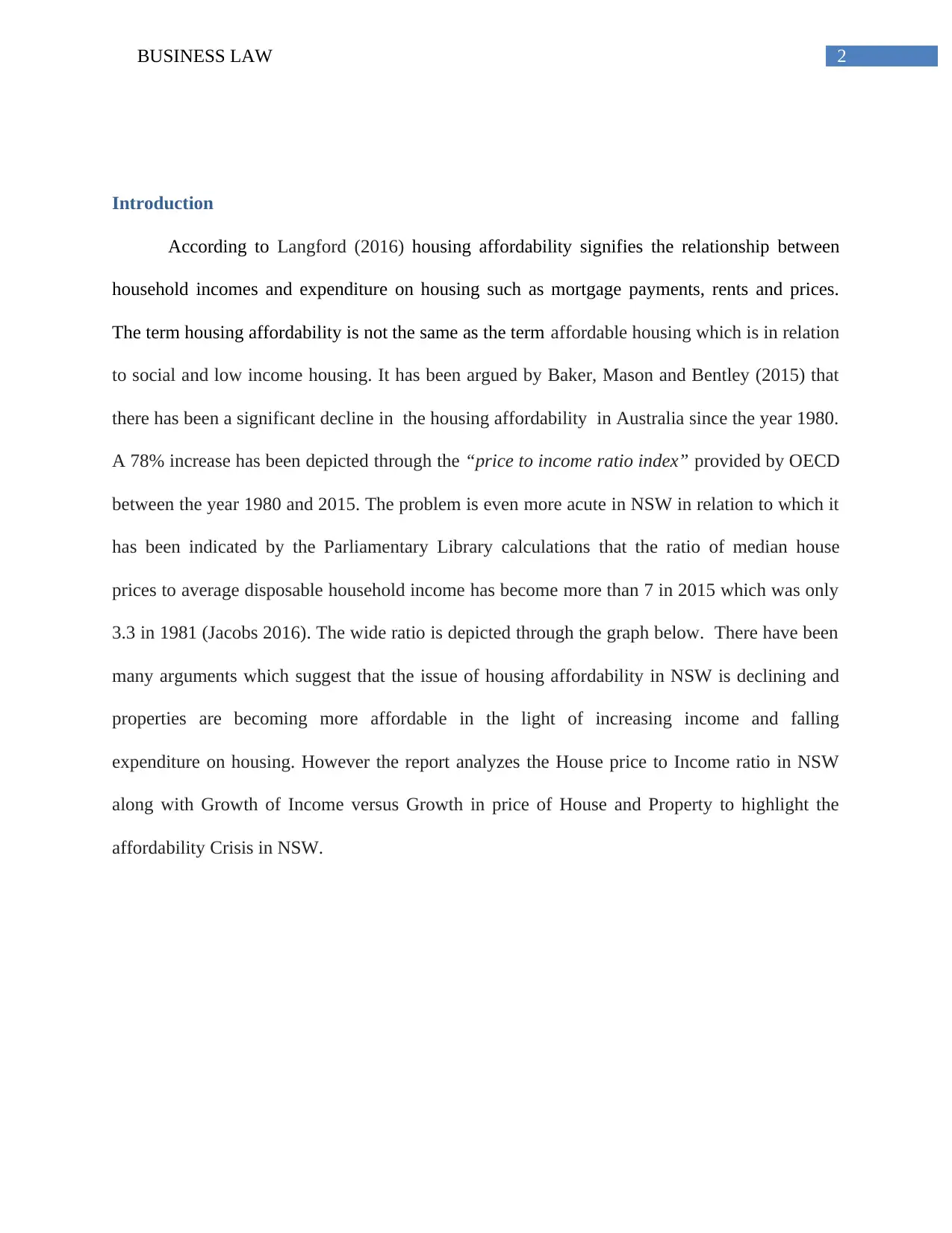
2BUSINESS LAW
Introduction
According to Langford (2016) housing affordability signifies the relationship between
household incomes and expenditure on housing such as mortgage payments, rents and prices.
The term housing affordability is not the same as the term affordable housing which is in relation
to social and low income housing. It has been argued by Baker, Mason and Bentley (2015) that
there has been a significant decline in the housing affordability in Australia since the year 1980.
A 78% increase has been depicted through the “price to income ratio index” provided by OECD
between the year 1980 and 2015. The problem is even more acute in NSW in relation to which it
has been indicated by the Parliamentary Library calculations that the ratio of median house
prices to average disposable household income has become more than 7 in 2015 which was only
3.3 in 1981 (Jacobs 2016). The wide ratio is depicted through the graph below. There have been
many arguments which suggest that the issue of housing affordability in NSW is declining and
properties are becoming more affordable in the light of increasing income and falling
expenditure on housing. However the report analyzes the House price to Income ratio in NSW
along with Growth of Income versus Growth in price of House and Property to highlight the
affordability Crisis in NSW.
Introduction
According to Langford (2016) housing affordability signifies the relationship between
household incomes and expenditure on housing such as mortgage payments, rents and prices.
The term housing affordability is not the same as the term affordable housing which is in relation
to social and low income housing. It has been argued by Baker, Mason and Bentley (2015) that
there has been a significant decline in the housing affordability in Australia since the year 1980.
A 78% increase has been depicted through the “price to income ratio index” provided by OECD
between the year 1980 and 2015. The problem is even more acute in NSW in relation to which it
has been indicated by the Parliamentary Library calculations that the ratio of median house
prices to average disposable household income has become more than 7 in 2015 which was only
3.3 in 1981 (Jacobs 2016). The wide ratio is depicted through the graph below. There have been
many arguments which suggest that the issue of housing affordability in NSW is declining and
properties are becoming more affordable in the light of increasing income and falling
expenditure on housing. However the report analyzes the House price to Income ratio in NSW
along with Growth of Income versus Growth in price of House and Property to highlight the
affordability Crisis in NSW.
⊘ This is a preview!⊘
Do you want full access?
Subscribe today to unlock all pages.

Trusted by 1+ million students worldwide
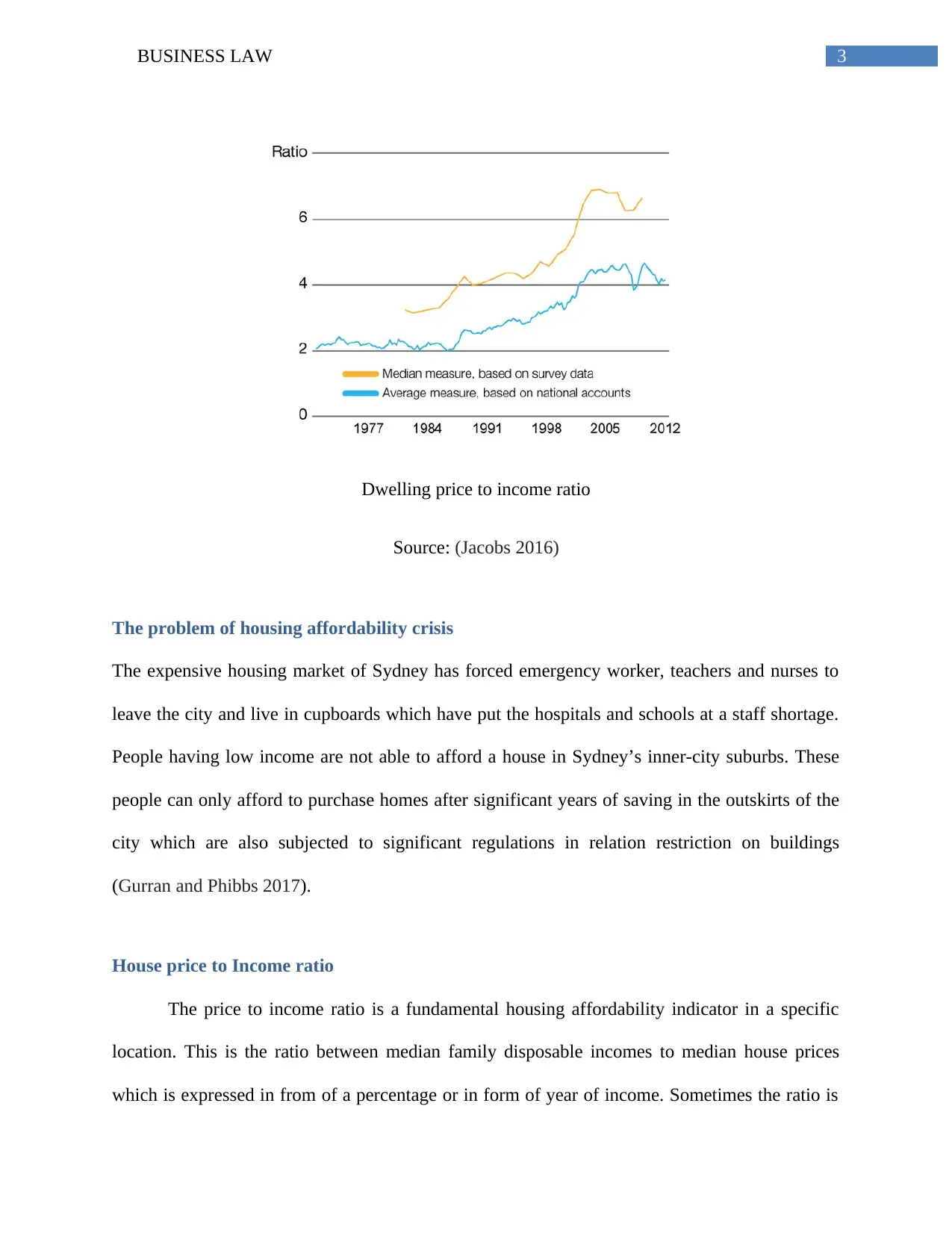
3BUSINESS LAW
Dwelling price to income ratio
Source: (Jacobs 2016)
The problem of housing affordability crisis
The expensive housing market of Sydney has forced emergency worker, teachers and nurses to
leave the city and live in cupboards which have put the hospitals and schools at a staff shortage.
People having low income are not able to afford a house in Sydney’s inner-city suburbs. These
people can only afford to purchase homes after significant years of saving in the outskirts of the
city which are also subjected to significant regulations in relation restriction on buildings
(Gurran and Phibbs 2017).
House price to Income ratio
The price to income ratio is a fundamental housing affordability indicator in a specific
location. This is the ratio between median family disposable incomes to median house prices
which is expressed in from of a percentage or in form of year of income. Sometimes the ratio is
Dwelling price to income ratio
Source: (Jacobs 2016)
The problem of housing affordability crisis
The expensive housing market of Sydney has forced emergency worker, teachers and nurses to
leave the city and live in cupboards which have put the hospitals and schools at a staff shortage.
People having low income are not able to afford a house in Sydney’s inner-city suburbs. These
people can only afford to purchase homes after significant years of saving in the outskirts of the
city which are also subjected to significant regulations in relation restriction on buildings
(Gurran and Phibbs 2017).
House price to Income ratio
The price to income ratio is a fundamental housing affordability indicator in a specific
location. This is the ratio between median family disposable incomes to median house prices
which is expressed in from of a percentage or in form of year of income. Sometimes the ratio is
Paraphrase This Document
Need a fresh take? Get an instant paraphrase of this document with our AI Paraphraser
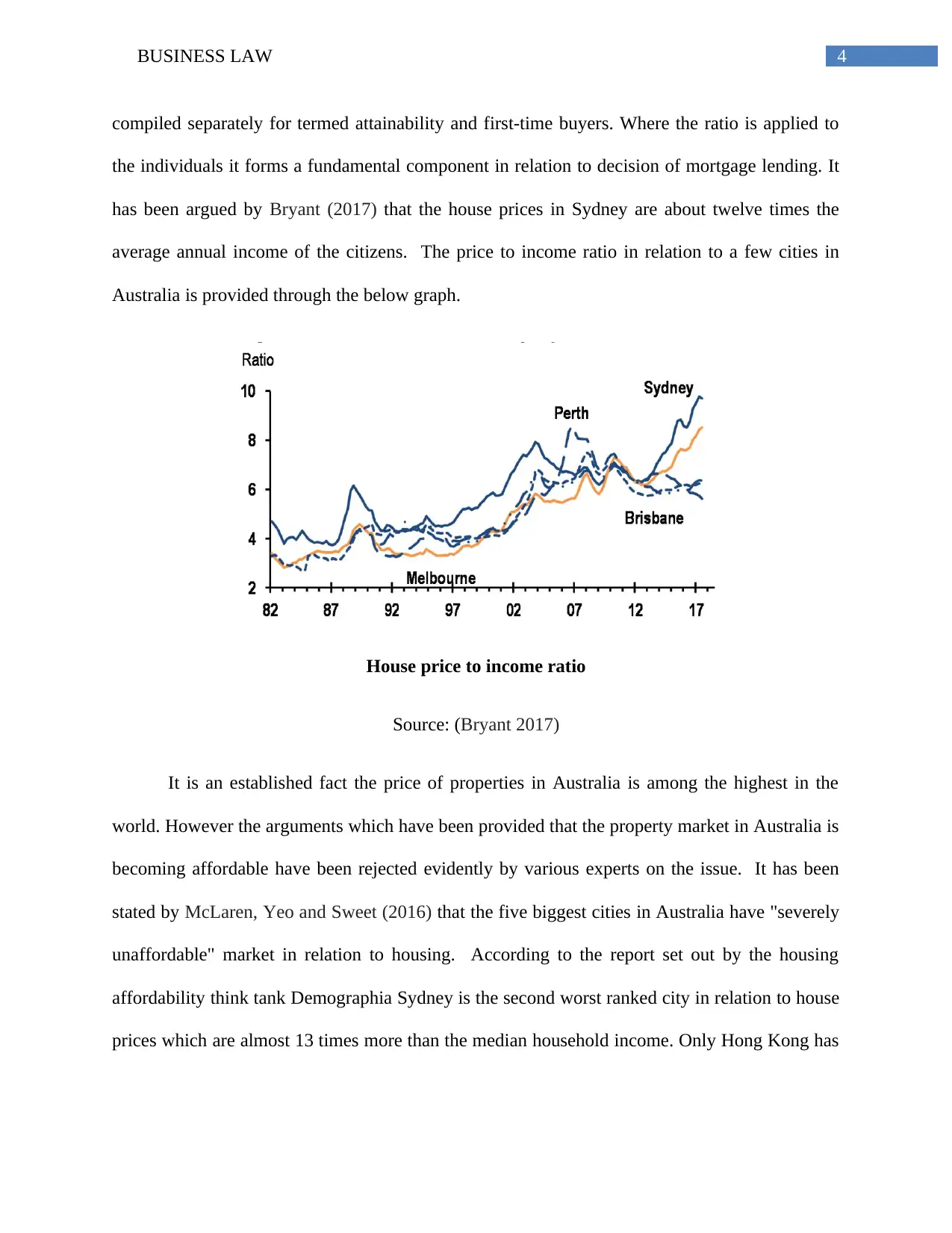
4BUSINESS LAW
compiled separately for termed attainability and first-time buyers. Where the ratio is applied to
the individuals it forms a fundamental component in relation to decision of mortgage lending. It
has been argued by Bryant (2017) that the house prices in Sydney are about twelve times the
average annual income of the citizens. The price to income ratio in relation to a few cities in
Australia is provided through the below graph.
House price to income ratio
Source: (Bryant 2017)
It is an established fact the price of properties in Australia is among the highest in the
world. However the arguments which have been provided that the property market in Australia is
becoming affordable have been rejected evidently by various experts on the issue. It has been
stated by McLaren, Yeo and Sweet (2016) that the five biggest cities in Australia have "severely
unaffordable" market in relation to housing. According to the report set out by the housing
affordability think tank Demographia Sydney is the second worst ranked city in relation to house
prices which are almost 13 times more than the median household income. Only Hong Kong has
compiled separately for termed attainability and first-time buyers. Where the ratio is applied to
the individuals it forms a fundamental component in relation to decision of mortgage lending. It
has been argued by Bryant (2017) that the house prices in Sydney are about twelve times the
average annual income of the citizens. The price to income ratio in relation to a few cities in
Australia is provided through the below graph.
House price to income ratio
Source: (Bryant 2017)
It is an established fact the price of properties in Australia is among the highest in the
world. However the arguments which have been provided that the property market in Australia is
becoming affordable have been rejected evidently by various experts on the issue. It has been
stated by McLaren, Yeo and Sweet (2016) that the five biggest cities in Australia have "severely
unaffordable" market in relation to housing. According to the report set out by the housing
affordability think tank Demographia Sydney is the second worst ranked city in relation to house
prices which are almost 13 times more than the median household income. Only Hong Kong has
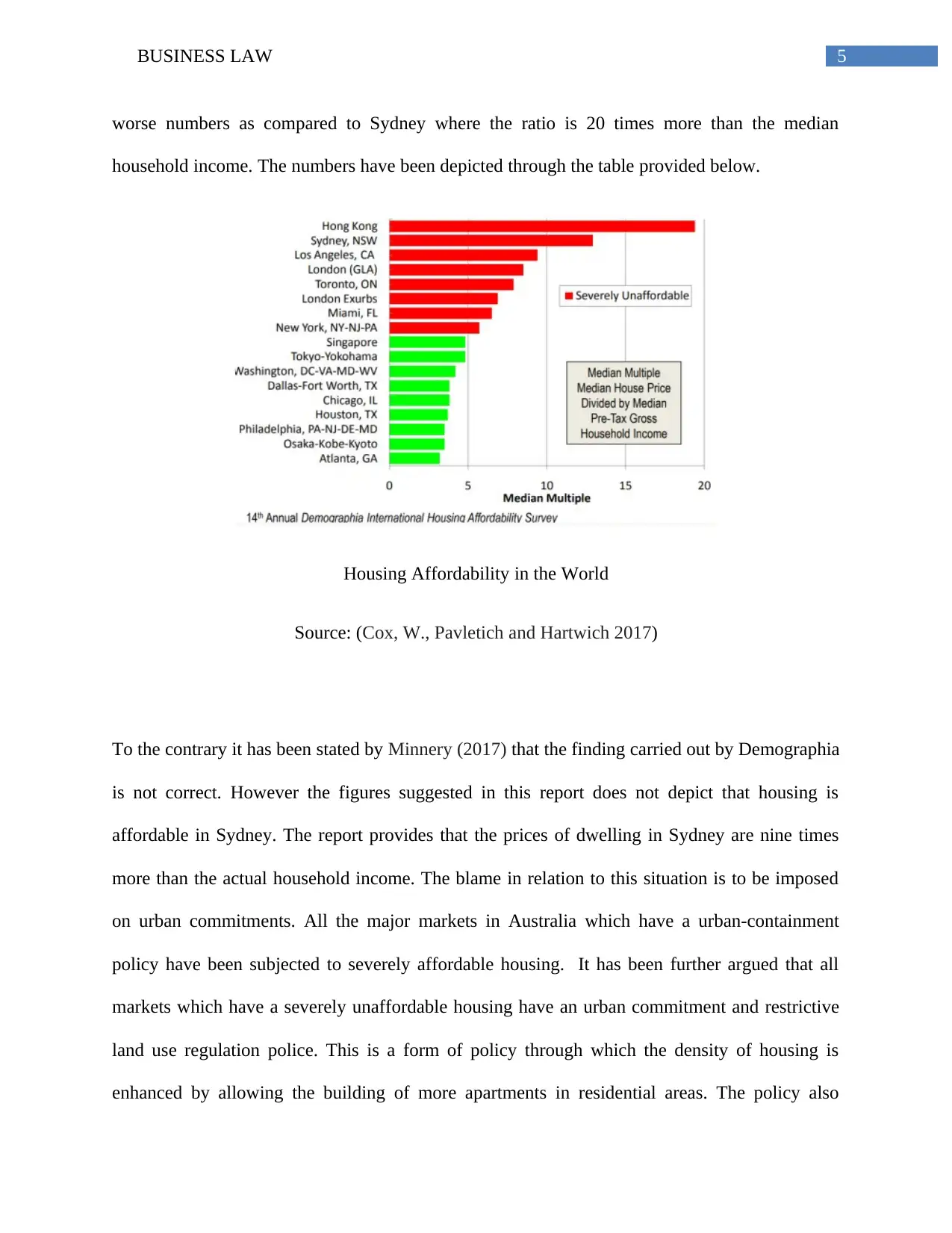
5BUSINESS LAW
worse numbers as compared to Sydney where the ratio is 20 times more than the median
household income. The numbers have been depicted through the table provided below.
Housing Affordability in the World
Source: (Cox, W., Pavletich and Hartwich 2017)
To the contrary it has been stated by Minnery (2017) that the finding carried out by Demographia
is not correct. However the figures suggested in this report does not depict that housing is
affordable in Sydney. The report provides that the prices of dwelling in Sydney are nine times
more than the actual household income. The blame in relation to this situation is to be imposed
on urban commitments. All the major markets in Australia which have a urban-containment
policy have been subjected to severely affordable housing. It has been further argued that all
markets which have a severely unaffordable housing have an urban commitment and restrictive
land use regulation police. This is a form of policy through which the density of housing is
enhanced by allowing the building of more apartments in residential areas. The policy also
worse numbers as compared to Sydney where the ratio is 20 times more than the median
household income. The numbers have been depicted through the table provided below.
Housing Affordability in the World
Source: (Cox, W., Pavletich and Hartwich 2017)
To the contrary it has been stated by Minnery (2017) that the finding carried out by Demographia
is not correct. However the figures suggested in this report does not depict that housing is
affordable in Sydney. The report provides that the prices of dwelling in Sydney are nine times
more than the actual household income. The blame in relation to this situation is to be imposed
on urban commitments. All the major markets in Australia which have a urban-containment
policy have been subjected to severely affordable housing. It has been further argued that all
markets which have a severely unaffordable housing have an urban commitment and restrictive
land use regulation police. This is a form of policy through which the density of housing is
enhanced by allowing the building of more apartments in residential areas. The policy also
⊘ This is a preview!⊘
Do you want full access?
Subscribe today to unlock all pages.

Trusted by 1+ million students worldwide
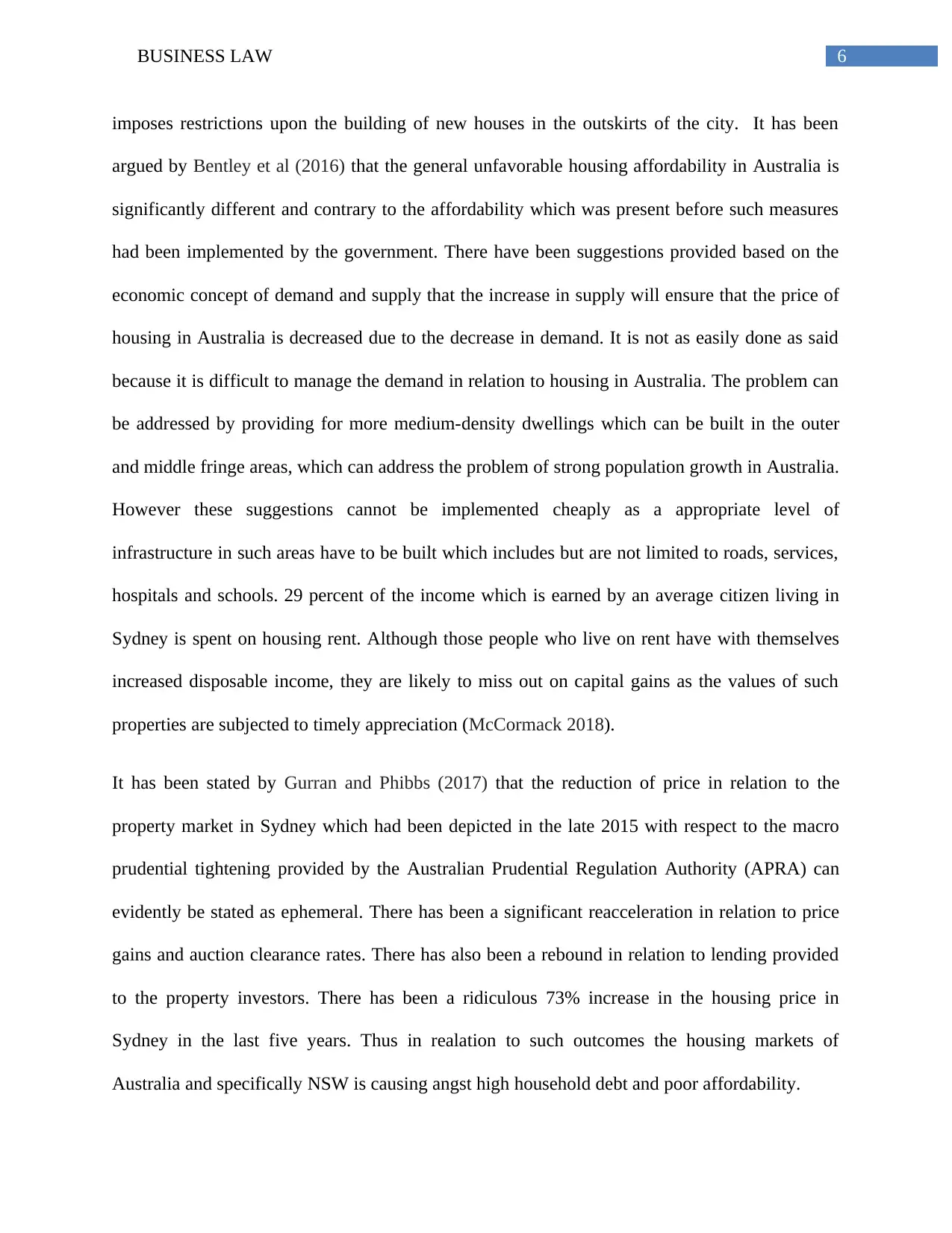
6BUSINESS LAW
imposes restrictions upon the building of new houses in the outskirts of the city. It has been
argued by Bentley et al (2016) that the general unfavorable housing affordability in Australia is
significantly different and contrary to the affordability which was present before such measures
had been implemented by the government. There have been suggestions provided based on the
economic concept of demand and supply that the increase in supply will ensure that the price of
housing in Australia is decreased due to the decrease in demand. It is not as easily done as said
because it is difficult to manage the demand in relation to housing in Australia. The problem can
be addressed by providing for more medium-density dwellings which can be built in the outer
and middle fringe areas, which can address the problem of strong population growth in Australia.
However these suggestions cannot be implemented cheaply as a appropriate level of
infrastructure in such areas have to be built which includes but are not limited to roads, services,
hospitals and schools. 29 percent of the income which is earned by an average citizen living in
Sydney is spent on housing rent. Although those people who live on rent have with themselves
increased disposable income, they are likely to miss out on capital gains as the values of such
properties are subjected to timely appreciation (McCormack 2018).
It has been stated by Gurran and Phibbs (2017) that the reduction of price in relation to the
property market in Sydney which had been depicted in the late 2015 with respect to the macro
prudential tightening provided by the Australian Prudential Regulation Authority (APRA) can
evidently be stated as ephemeral. There has been a significant reacceleration in relation to price
gains and auction clearance rates. There has also been a rebound in relation to lending provided
to the property investors. There has been a ridiculous 73% increase in the housing price in
Sydney in the last five years. Thus in realation to such outcomes the housing markets of
Australia and specifically NSW is causing angst high household debt and poor affordability.
imposes restrictions upon the building of new houses in the outskirts of the city. It has been
argued by Bentley et al (2016) that the general unfavorable housing affordability in Australia is
significantly different and contrary to the affordability which was present before such measures
had been implemented by the government. There have been suggestions provided based on the
economic concept of demand and supply that the increase in supply will ensure that the price of
housing in Australia is decreased due to the decrease in demand. It is not as easily done as said
because it is difficult to manage the demand in relation to housing in Australia. The problem can
be addressed by providing for more medium-density dwellings which can be built in the outer
and middle fringe areas, which can address the problem of strong population growth in Australia.
However these suggestions cannot be implemented cheaply as a appropriate level of
infrastructure in such areas have to be built which includes but are not limited to roads, services,
hospitals and schools. 29 percent of the income which is earned by an average citizen living in
Sydney is spent on housing rent. Although those people who live on rent have with themselves
increased disposable income, they are likely to miss out on capital gains as the values of such
properties are subjected to timely appreciation (McCormack 2018).
It has been stated by Gurran and Phibbs (2017) that the reduction of price in relation to the
property market in Sydney which had been depicted in the late 2015 with respect to the macro
prudential tightening provided by the Australian Prudential Regulation Authority (APRA) can
evidently be stated as ephemeral. There has been a significant reacceleration in relation to price
gains and auction clearance rates. There has also been a rebound in relation to lending provided
to the property investors. There has been a ridiculous 73% increase in the housing price in
Sydney in the last five years. Thus in realation to such outcomes the housing markets of
Australia and specifically NSW is causing angst high household debt and poor affordability.
Paraphrase This Document
Need a fresh take? Get an instant paraphrase of this document with our AI Paraphraser
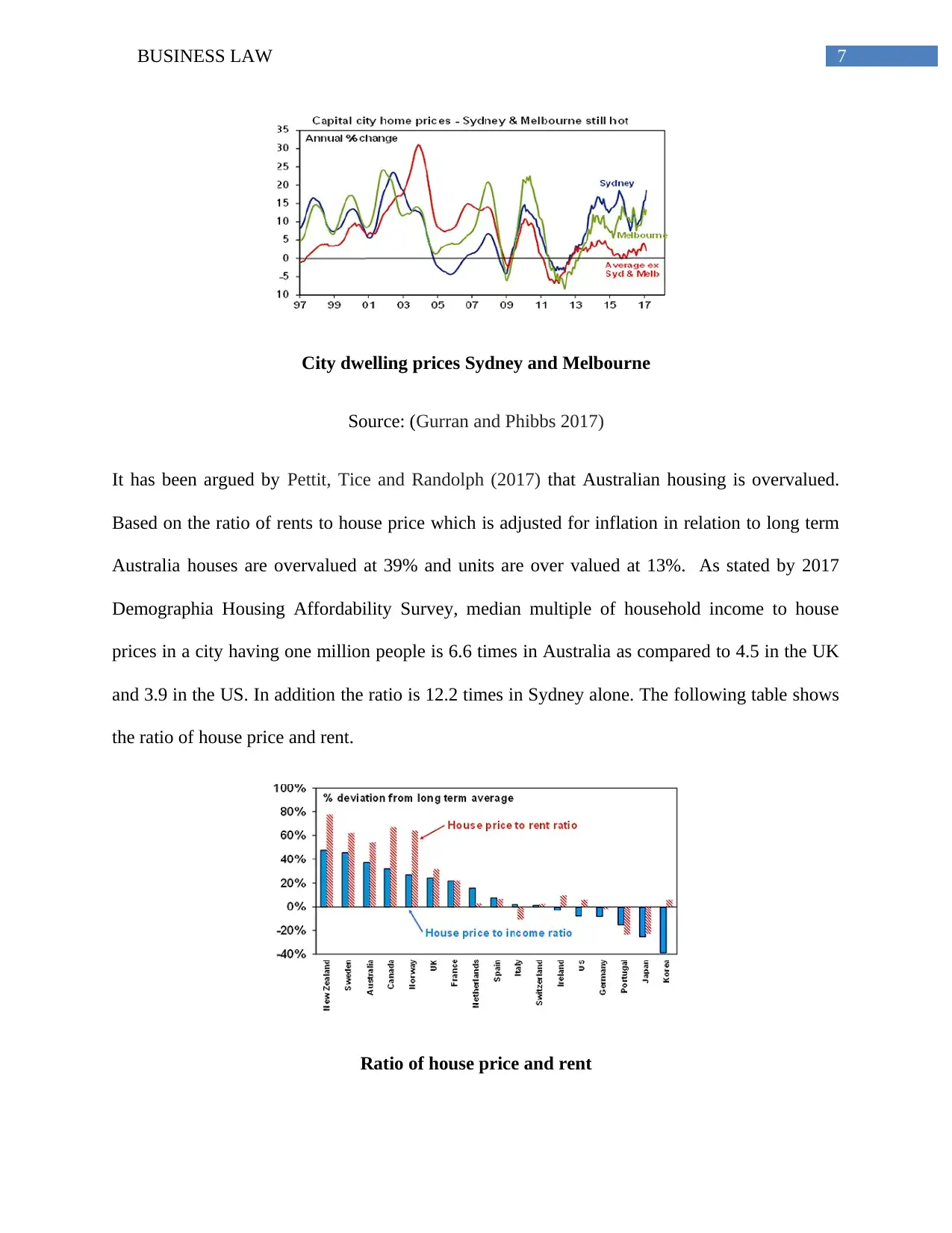
7BUSINESS LAW
City dwelling prices Sydney and Melbourne
Source: (Gurran and Phibbs 2017)
It has been argued by Pettit, Tice and Randolph (2017) that Australian housing is overvalued.
Based on the ratio of rents to house price which is adjusted for inflation in relation to long term
Australia houses are overvalued at 39% and units are over valued at 13%. As stated by 2017
Demographia Housing Affordability Survey, median multiple of household income to house
prices in a city having one million people is 6.6 times in Australia as compared to 4.5 in the UK
and 3.9 in the US. In addition the ratio is 12.2 times in Sydney alone. The following table shows
the ratio of house price and rent.
Ratio of house price and rent
City dwelling prices Sydney and Melbourne
Source: (Gurran and Phibbs 2017)
It has been argued by Pettit, Tice and Randolph (2017) that Australian housing is overvalued.
Based on the ratio of rents to house price which is adjusted for inflation in relation to long term
Australia houses are overvalued at 39% and units are over valued at 13%. As stated by 2017
Demographia Housing Affordability Survey, median multiple of household income to house
prices in a city having one million people is 6.6 times in Australia as compared to 4.5 in the UK
and 3.9 in the US. In addition the ratio is 12.2 times in Sydney alone. The following table shows
the ratio of house price and rent.
Ratio of house price and rent
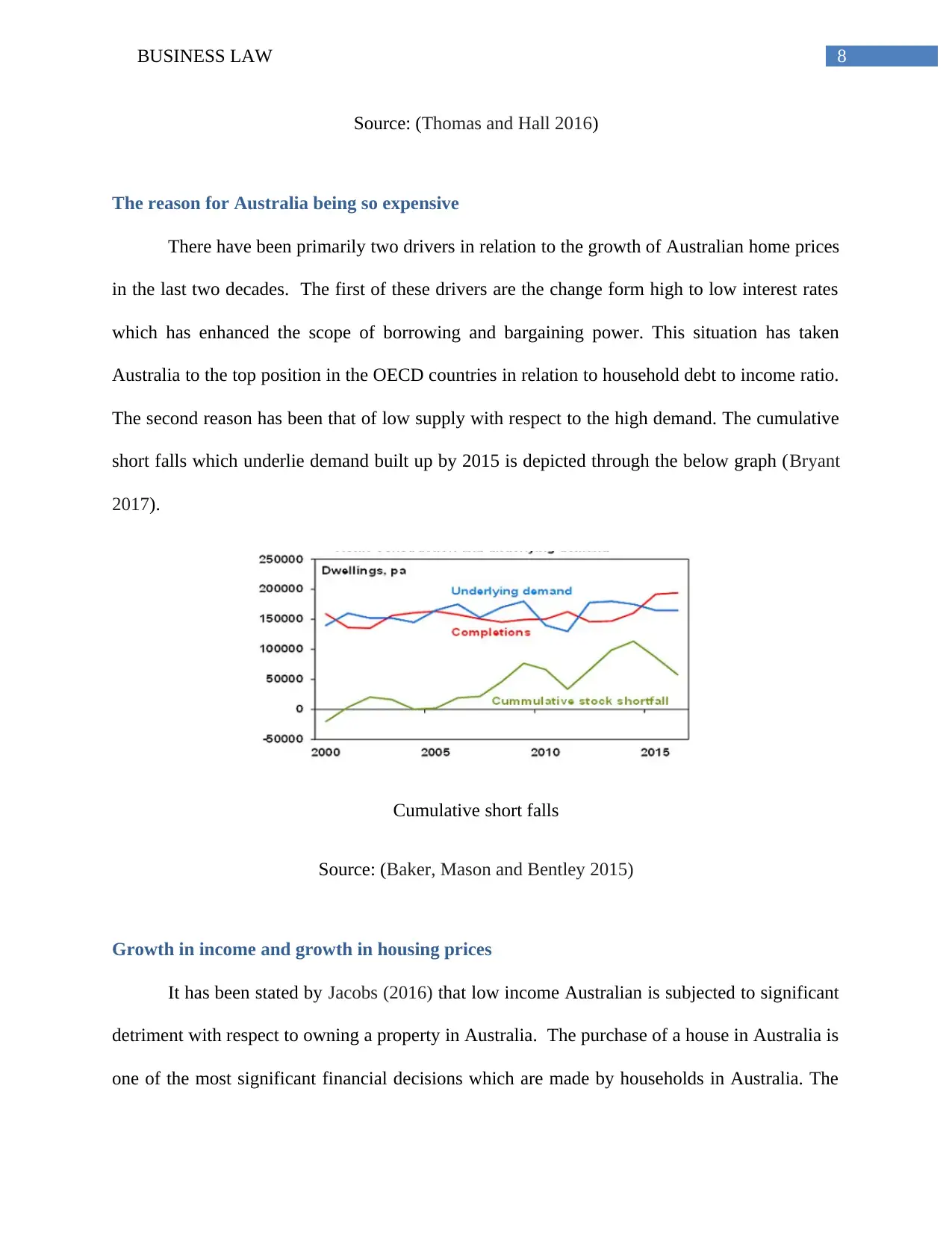
8BUSINESS LAW
Source: (Thomas and Hall 2016)
The reason for Australia being so expensive
There have been primarily two drivers in relation to the growth of Australian home prices
in the last two decades. The first of these drivers are the change form high to low interest rates
which has enhanced the scope of borrowing and bargaining power. This situation has taken
Australia to the top position in the OECD countries in relation to household debt to income ratio.
The second reason has been that of low supply with respect to the high demand. The cumulative
short falls which underlie demand built up by 2015 is depicted through the below graph (Bryant
2017).
Cumulative short falls
Source: (Baker, Mason and Bentley 2015)
Growth in income and growth in housing prices
It has been stated by Jacobs (2016) that low income Australian is subjected to significant
detriment with respect to owning a property in Australia. The purchase of a house in Australia is
one of the most significant financial decisions which are made by households in Australia. The
Source: (Thomas and Hall 2016)
The reason for Australia being so expensive
There have been primarily two drivers in relation to the growth of Australian home prices
in the last two decades. The first of these drivers are the change form high to low interest rates
which has enhanced the scope of borrowing and bargaining power. This situation has taken
Australia to the top position in the OECD countries in relation to household debt to income ratio.
The second reason has been that of low supply with respect to the high demand. The cumulative
short falls which underlie demand built up by 2015 is depicted through the below graph (Bryant
2017).
Cumulative short falls
Source: (Baker, Mason and Bentley 2015)
Growth in income and growth in housing prices
It has been stated by Jacobs (2016) that low income Australian is subjected to significant
detriment with respect to owning a property in Australia. The purchase of a house in Australia is
one of the most significant financial decisions which are made by households in Australia. The
⊘ This is a preview!⊘
Do you want full access?
Subscribe today to unlock all pages.

Trusted by 1+ million students worldwide
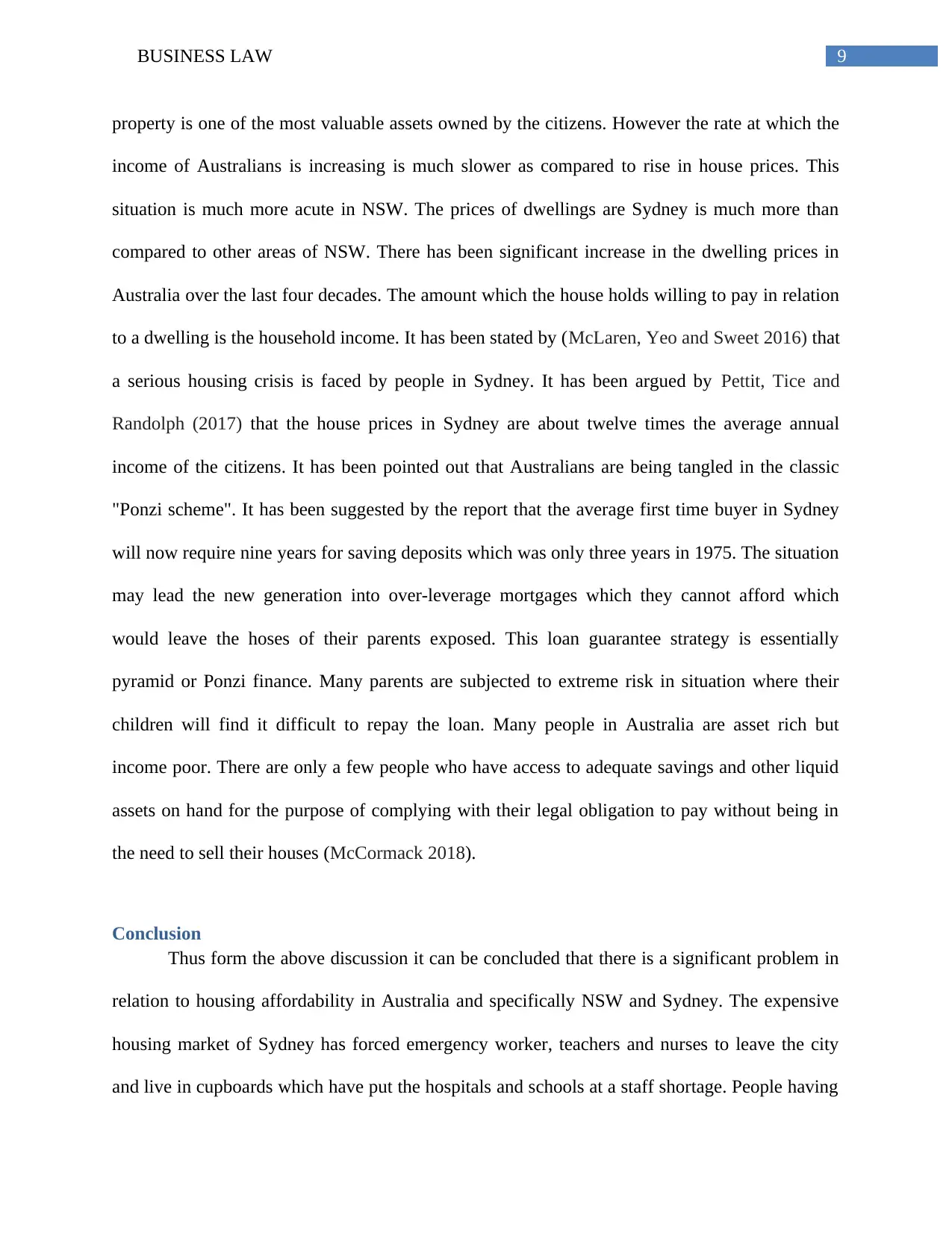
9BUSINESS LAW
property is one of the most valuable assets owned by the citizens. However the rate at which the
income of Australians is increasing is much slower as compared to rise in house prices. This
situation is much more acute in NSW. The prices of dwellings are Sydney is much more than
compared to other areas of NSW. There has been significant increase in the dwelling prices in
Australia over the last four decades. The amount which the house holds willing to pay in relation
to a dwelling is the household income. It has been stated by (McLaren, Yeo and Sweet 2016) that
a serious housing crisis is faced by people in Sydney. It has been argued by Pettit, Tice and
Randolph (2017) that the house prices in Sydney are about twelve times the average annual
income of the citizens. It has been pointed out that Australians are being tangled in the classic
"Ponzi scheme". It has been suggested by the report that the average first time buyer in Sydney
will now require nine years for saving deposits which was only three years in 1975. The situation
may lead the new generation into over-leverage mortgages which they cannot afford which
would leave the hoses of their parents exposed. This loan guarantee strategy is essentially
pyramid or Ponzi finance. Many parents are subjected to extreme risk in situation where their
children will find it difficult to repay the loan. Many people in Australia are asset rich but
income poor. There are only a few people who have access to adequate savings and other liquid
assets on hand for the purpose of complying with their legal obligation to pay without being in
the need to sell their houses (McCormack 2018).
Conclusion
Thus form the above discussion it can be concluded that there is a significant problem in
relation to housing affordability in Australia and specifically NSW and Sydney. The expensive
housing market of Sydney has forced emergency worker, teachers and nurses to leave the city
and live in cupboards which have put the hospitals and schools at a staff shortage. People having
property is one of the most valuable assets owned by the citizens. However the rate at which the
income of Australians is increasing is much slower as compared to rise in house prices. This
situation is much more acute in NSW. The prices of dwellings are Sydney is much more than
compared to other areas of NSW. There has been significant increase in the dwelling prices in
Australia over the last four decades. The amount which the house holds willing to pay in relation
to a dwelling is the household income. It has been stated by (McLaren, Yeo and Sweet 2016) that
a serious housing crisis is faced by people in Sydney. It has been argued by Pettit, Tice and
Randolph (2017) that the house prices in Sydney are about twelve times the average annual
income of the citizens. It has been pointed out that Australians are being tangled in the classic
"Ponzi scheme". It has been suggested by the report that the average first time buyer in Sydney
will now require nine years for saving deposits which was only three years in 1975. The situation
may lead the new generation into over-leverage mortgages which they cannot afford which
would leave the hoses of their parents exposed. This loan guarantee strategy is essentially
pyramid or Ponzi finance. Many parents are subjected to extreme risk in situation where their
children will find it difficult to repay the loan. Many people in Australia are asset rich but
income poor. There are only a few people who have access to adequate savings and other liquid
assets on hand for the purpose of complying with their legal obligation to pay without being in
the need to sell their houses (McCormack 2018).
Conclusion
Thus form the above discussion it can be concluded that there is a significant problem in
relation to housing affordability in Australia and specifically NSW and Sydney. The expensive
housing market of Sydney has forced emergency worker, teachers and nurses to leave the city
and live in cupboards which have put the hospitals and schools at a staff shortage. People having
Paraphrase This Document
Need a fresh take? Get an instant paraphrase of this document with our AI Paraphraser
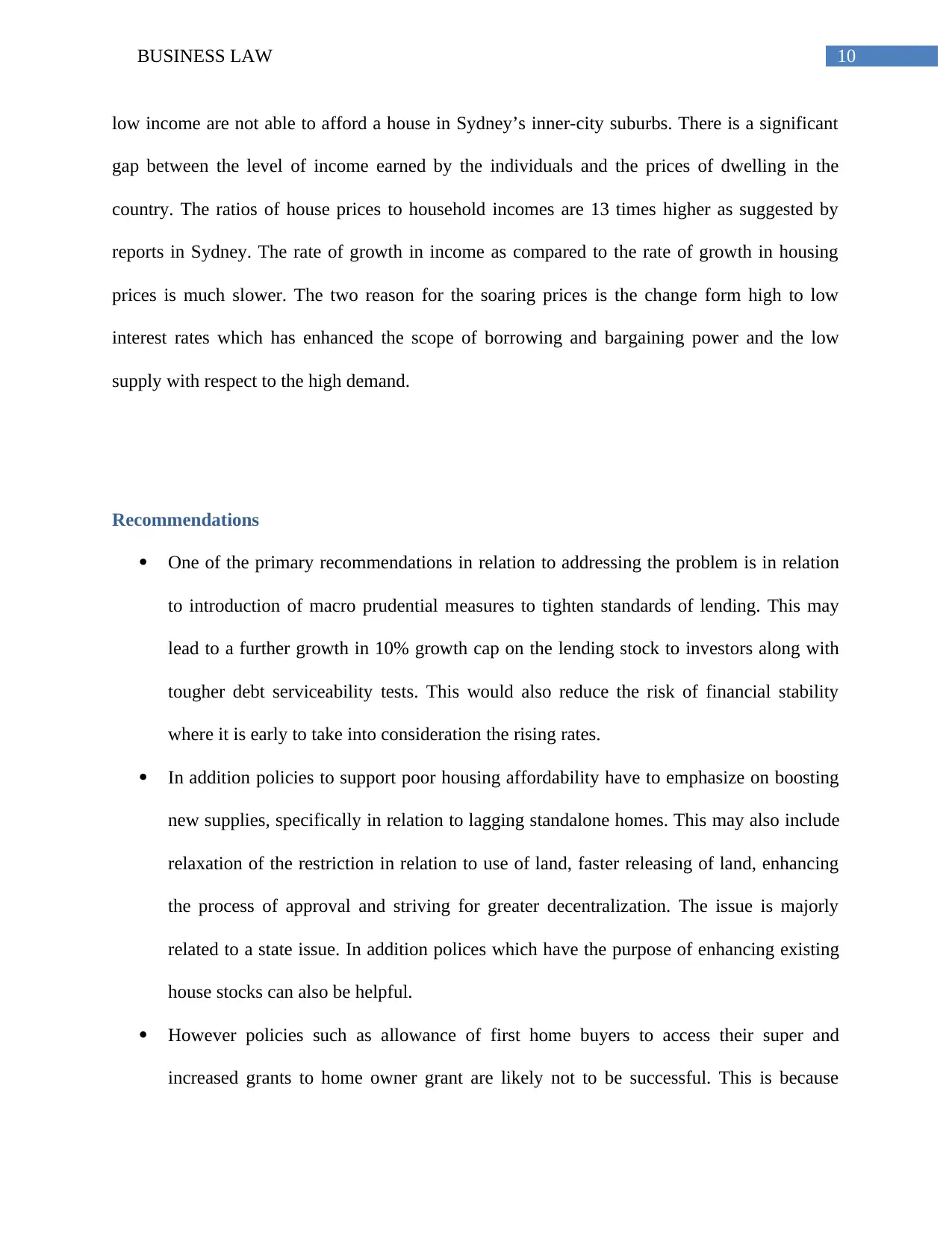
10BUSINESS LAW
low income are not able to afford a house in Sydney’s inner-city suburbs. There is a significant
gap between the level of income earned by the individuals and the prices of dwelling in the
country. The ratios of house prices to household incomes are 13 times higher as suggested by
reports in Sydney. The rate of growth in income as compared to the rate of growth in housing
prices is much slower. The two reason for the soaring prices is the change form high to low
interest rates which has enhanced the scope of borrowing and bargaining power and the low
supply with respect to the high demand.
Recommendations
One of the primary recommendations in relation to addressing the problem is in relation
to introduction of macro prudential measures to tighten standards of lending. This may
lead to a further growth in 10% growth cap on the lending stock to investors along with
tougher debt serviceability tests. This would also reduce the risk of financial stability
where it is early to take into consideration the rising rates.
In addition policies to support poor housing affordability have to emphasize on boosting
new supplies, specifically in relation to lagging standalone homes. This may also include
relaxation of the restriction in relation to use of land, faster releasing of land, enhancing
the process of approval and striving for greater decentralization. The issue is majorly
related to a state issue. In addition polices which have the purpose of enhancing existing
house stocks can also be helpful.
However policies such as allowance of first home buyers to access their super and
increased grants to home owner grant are likely not to be successful. This is because
low income are not able to afford a house in Sydney’s inner-city suburbs. There is a significant
gap between the level of income earned by the individuals and the prices of dwelling in the
country. The ratios of house prices to household incomes are 13 times higher as suggested by
reports in Sydney. The rate of growth in income as compared to the rate of growth in housing
prices is much slower. The two reason for the soaring prices is the change form high to low
interest rates which has enhanced the scope of borrowing and bargaining power and the low
supply with respect to the high demand.
Recommendations
One of the primary recommendations in relation to addressing the problem is in relation
to introduction of macro prudential measures to tighten standards of lending. This may
lead to a further growth in 10% growth cap on the lending stock to investors along with
tougher debt serviceability tests. This would also reduce the risk of financial stability
where it is early to take into consideration the rising rates.
In addition policies to support poor housing affordability have to emphasize on boosting
new supplies, specifically in relation to lagging standalone homes. This may also include
relaxation of the restriction in relation to use of land, faster releasing of land, enhancing
the process of approval and striving for greater decentralization. The issue is majorly
related to a state issue. In addition polices which have the purpose of enhancing existing
house stocks can also be helpful.
However policies such as allowance of first home buyers to access their super and
increased grants to home owner grant are likely not to be successful. This is because
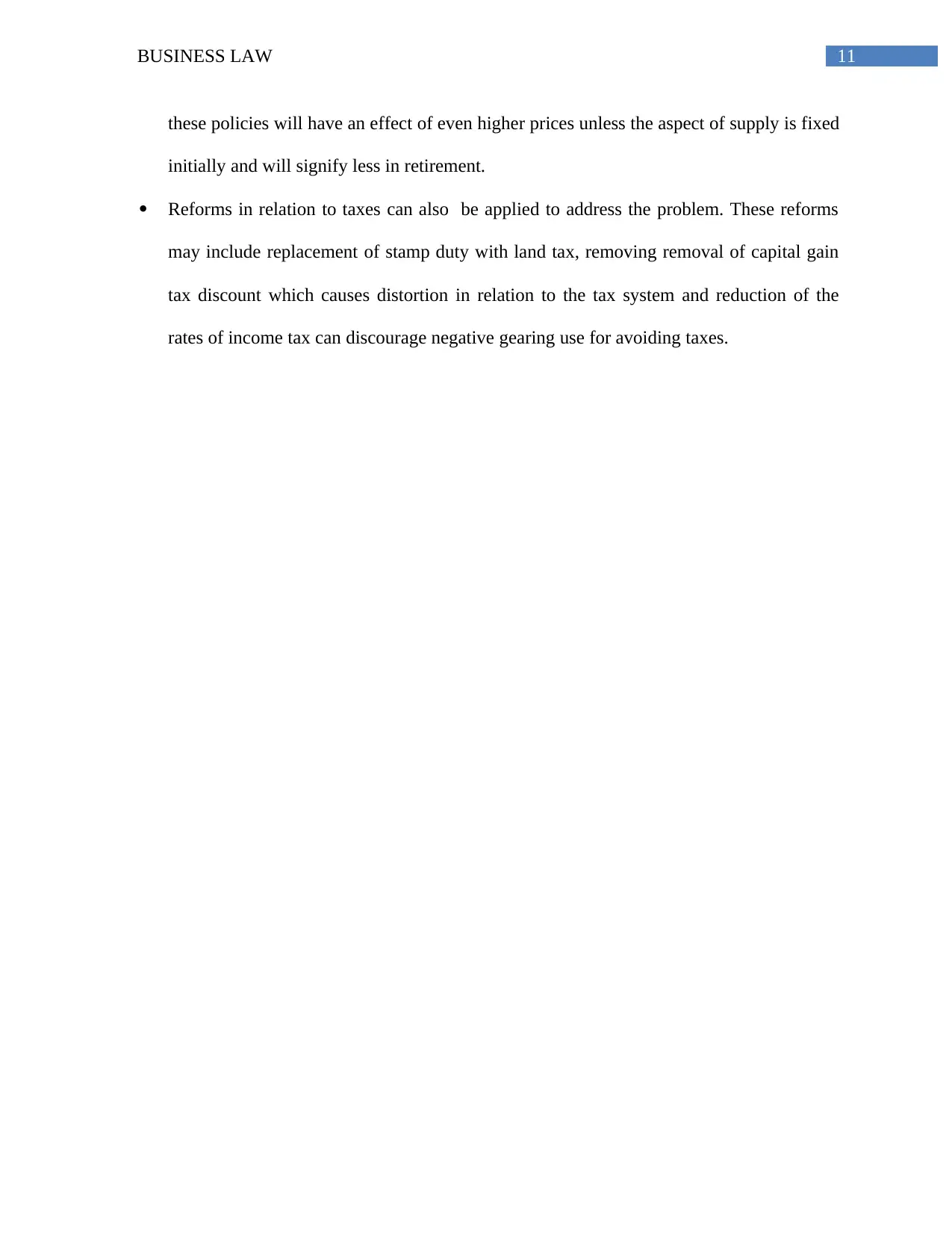
11BUSINESS LAW
these policies will have an effect of even higher prices unless the aspect of supply is fixed
initially and will signify less in retirement.
Reforms in relation to taxes can also be applied to address the problem. These reforms
may include replacement of stamp duty with land tax, removing removal of capital gain
tax discount which causes distortion in relation to the tax system and reduction of the
rates of income tax can discourage negative gearing use for avoiding taxes.
these policies will have an effect of even higher prices unless the aspect of supply is fixed
initially and will signify less in retirement.
Reforms in relation to taxes can also be applied to address the problem. These reforms
may include replacement of stamp duty with land tax, removing removal of capital gain
tax discount which causes distortion in relation to the tax system and reduction of the
rates of income tax can discourage negative gearing use for avoiding taxes.
⊘ This is a preview!⊘
Do you want full access?
Subscribe today to unlock all pages.

Trusted by 1+ million students worldwide
1 out of 14
Related Documents
Your All-in-One AI-Powered Toolkit for Academic Success.
+13062052269
info@desklib.com
Available 24*7 on WhatsApp / Email
![[object Object]](/_next/static/media/star-bottom.7253800d.svg)
Unlock your academic potential
Copyright © 2020–2025 A2Z Services. All Rights Reserved. Developed and managed by ZUCOL.




